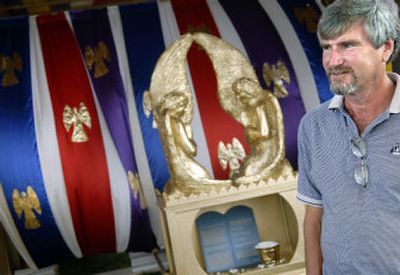Mobile mansion recounts holy journey

In big purple lettering, the sign on the corner of 16th and Sullivan proclaimed that Messiah’s Mansion, or in MTV speak, God’s Crib, was just around the corner with ample parking.
Its gravity wasn’t exactly pulling the burbs’ southbound motoring masses into the left turn lane. They were caught up in a little road rage and seemingly unaware of the white-curtained walls of the quarter-acre compound just southeast of their red traffic light. Two days earlier, the site had been occupied by subdivision sod.
“Hey, did you see that?” yelled a sunburned man leaning out the driver’s window of a late model Chevy pickup. Sneering through a moustache only John Bolton could love, he pointed an accusatory finger at a woman in a Camry who just cut him off. “She flipped me off.”
Had he seen the arrow for Messiah’s Mansion? Was he tempted by the promise of free admission? The questions seemed to take the starch out of the man’s gesturing hand. Then the light turned green and the entire school of cars swam through the transparent waves of their own engine heat without turning.
And so it has occurred everywhere Clayton and Carolyn Leinneweber have raised the mansion’s tent walls and, with the help of volunteers, pounded in the 600 metal stakes to keep it upright. The curious meander in to see what it’s all about.
The disinterested drive on by.
Simply put, the mansion is a life-sized replica of a traveling sanctuary the Hebrews built in about 1445 B.C. The Old Testament states that God gave the plans for the sanctuary, also called a tabernacle, to Moses. It is where God is said to have lived while his followers wandered the desert for 40 years.
And it is where God’s followers were able to shed their sins and guilt through animals sacrificed on an altar in order to communicate with God directly.
The Leinnewebers have been traversing America in a semitruck setting up their replica since 2003. Before then, they owned a restaurant and bakery. They take winters off because the cold weather is bad for turnout.
Clayton Leinneweber teaches sophomore and junior Bible class at Oklahoma Academy, a Seventh-day Adventist school in Harrah, Okla. His students learn to set up the mansion and give tours as part of their curriculum.
“It’s given me a sense of responsibility,” Clayton Leinneweber said. “The Lord has given this to me and I have this responsibility to share it.”
It’s a hard story to share, at least beyond church circles. To drive-by traffic, Messiah’s Mansion appears to be a large fence made of white tarp with a modest structure within its confines. The tabernacle – in which God is said to have resided behind a partition because no one could withstand God’s brilliance – is dwarfed by the split-level homes to the east and west of the site.
Yes, Leinneweber said, by comparison the sanctuary is small, but it was made to be carried across the desert, with each family responsible for packing a particular piece. Fully loaded, the Leinneweber’s semitruck tips weigh station scales at more than 68,000 pounds.
The Cliff’s Notes version of the Hebrew journey goes something like this:
Not long after the beginning of time, the Hebrews hit a rough patch in the Promised Land. Famine forced them to go looking for a new place to live.
They found food and jobs in Egypt and resettled, but the 600,000 Hebrew males of fighting age worried the Egyptian pharaoh, who allayed his fears by enslaving the new folks on the block and killing off their male babies.
But – there’s always a but – one Hebrew family sent their baby boy downriver rather than see him killed. An Egyptian princess adopted him, unknowingly guaranteeing that at least one male of this Hebrew generation would live to lead. The boy, Moses, eventually led the Hebrews out of Egypt and into the desert, which they wandered for 40 years.
Early in the desert journey, God tipped the scales in favor of the Hebrews surviving. He declared them his official people. He provided them water wherever they went and furnished the tribe of several million people with a cloud that rained manna, a life-sustaining food.
Much of the time in the desert is spent following this cloud.
The tabernacle becomes the epicenter of wherever they camp, assuring them they are with God.
Theirs is a big world filled with uncertainty.
And so is ours, Leinneweber would argue.
He ties the ritual of the sanctuary to modern Christianity as he stands before a model of the Ark of the Covenant.
One of his students steps through a fence and informs Leinneweber that a busload of people has driven an hour just to see the sanctuary. The tabernacle is still being put together, he said. It won’t be ready for visitors until the following day.
But then he pauses and invites the group in anyway.
“Ask them if they can come back at 6:45 p.m.,” he said.